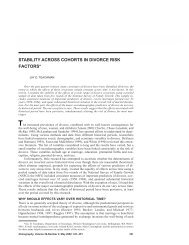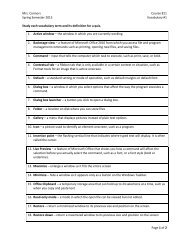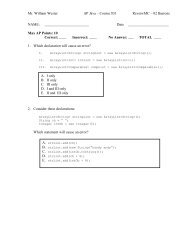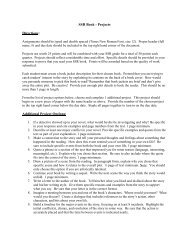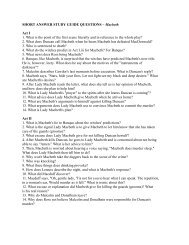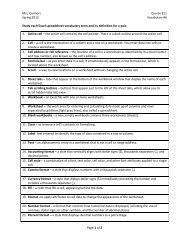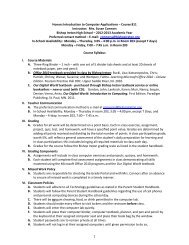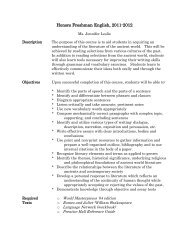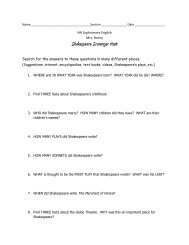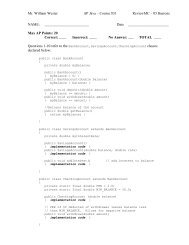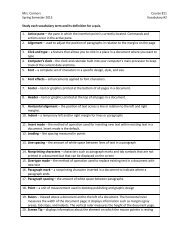Create successful ePaper yourself
Turn your PDF publications into a flip-book with our unique Google optimized e-Paper software.
Mr. William Wester AP Java – Course 831 <strong>Review</strong>MC – <strong>04</strong> <strong>Barrons</strong><br />
NAME: ________________________ Date ______________________<br />
Max AP Points: 18<br />
Correct: ____ Incorrect: ____ No Answer: ___ TOTAL ____<br />
1. Here is a program segment to find the quantity base exp . Both base and exp are entered at<br />
the keyboard?<br />
System.out.println(“Enter base and exponent: ”);<br />
double base = IO.readDouble(); // read user input<br />
double exp = IO.readDouble(); // read user input<br />
code to find power<br />
System.out.print(base + “ raised to the power ” + exp);<br />
System.out.println(“ equals ” + power);<br />
Which is a correct replacement for code to find power ?<br />
I. double power;<br />
Math m = new Math();<br />
power = m.pow(base, exp);<br />
II. double power;<br />
power = Math.pow(base, exp);<br />
III. int power;<br />
power = Math.pow(base, exp);<br />
A. I only<br />
B. II only<br />
C. III only<br />
D. I and II only<br />
E. I and III only<br />
2. Consider the squareRoot method defined below:<br />
// Precondition: value of d ≥ 0<br />
// Postcondition: returns a Double whose value is the<br />
// square root of the value represented by d<br />
public Double squareRoot(Double d)<br />
{ implementation code }<br />
Which implementation code satisfies the postcondition?<br />
I. double x = d.doubleValue();<br />
x = Math.sqrt(x);<br />
return new Double(x);<br />
II. return new Double(Math.sqrt(d.doubleValue()));<br />
III. return ((Double) Math).sqrt(d.doubleValue());<br />
A. I only<br />
B. I and II only<br />
C. I and III only<br />
D. II and III only<br />
E. I, II, III
Mr. William Wester AP Java – Course 831 <strong>Review</strong>MC – <strong>04</strong> <strong>Barrons</strong><br />
3. Here are some examples of negative numbers rounded to the nearest integer.<br />
Negative real number Rounded to nearest integer<br />
-3.5 -4<br />
-8.97 -9<br />
-5.0 -5<br />
-2.487 -2<br />
-0.2 0<br />
Refer to the declaration: double d = 4.67;<br />
Which of the following correctly rounds d to the nearest integer?<br />
A. int rounded = Math.abs(d);<br />
B. Random r = new Random();<br />
int rounded = r.nextInt(d);<br />
C. int rounded = (int) (d – 0.5);<br />
D. int rounded = (int) (d + 0.5);<br />
E. int rounded = Math.abs(int) (d - 0.5));<br />
4. Consider the code segment<br />
Integer i = new Integer(20);<br />
more code<br />
Which of the following replacements for more code correctly sets i to have an integer<br />
value of 25?<br />
I. i = new Integer(25);<br />
II. i.intValue() = 25;<br />
III. Integer j = new Integer(25);<br />
i = j;<br />
A. I only<br />
B. II only<br />
C. III only<br />
D. I and III only<br />
E. II and III only
Mr. William Wester AP Java – Course 831 <strong>Review</strong>MC – <strong>04</strong> <strong>Barrons</strong><br />
5. A program is to simulate plant life under harsh conditions. In the program, plants die<br />
randomly according to some probability. Here is part of a Plant class defined in the<br />
program.<br />
public class Plant<br />
{<br />
// create Random number generator for class<br />
public static Random r = new Random();<br />
private double myProbDeath; // probability that plant dies<br />
// real number between 0 and 1<br />
// other private instance variables<br />
}<br />
public Plant(double probDeath, other parameters)<br />
{<br />
myProbDeath = probDeath;<br />
initialize other instance variables<br />
}<br />
// plant dies<br />
public void die()<br />
{<br />
statement to generate random number<br />
if (test to determine if plant dies)<br />
code for death<br />
else<br />
code for living<br />
}<br />
// other methods<br />
Which of the following are correct replacements for<br />
(1) statement to generate random number<br />
(2) test to determine if plant dies<br />
A. (1) double x = r.nextDouble();<br />
(2) x == myProbDeath<br />
B. (1) double x = r.nextDouble();<br />
(2) x > myProbDeath<br />
C. (1) double x = r.nextDouble();<br />
(2) x < myProbDeath<br />
D. (1) int x = r.nextInt(100) + 1;<br />
(2) x < (int)myProbDeath<br />
E. (1) int x = r.nextInt(100) + 1;<br />
(2) x == (int)myProbDeath
Mr. William Wester AP Java – Course 831 <strong>Review</strong>MC – <strong>04</strong> <strong>Barrons</strong><br />
6. Consider these declarations:<br />
Integer intOb = new Integer(3);<br />
Object ob = new Integer(4);<br />
Double doubOb = new Double(3.0);<br />
Which of the following will not cause an error?<br />
A. if ((Integer) ob.compareTo(intOb) < 0) . . .<br />
B. if (ob.compareTo(intOb) < 0) . . .<br />
C. if (intOb.compareTo(doubOb) < 0) . . .<br />
D. if (doubOb.compareTo(intOb) < 0) . . .<br />
E. if (intOb.compareTo(ob) < 0) . . .<br />
7. Refer to these declarations:<br />
Integer k = new Integer(8);<br />
Integer m = new Integer(4);<br />
Which test will not generate an error?<br />
I. if (k.intValue() == m.intValue()) . . .<br />
II. if ((k.intValue()).equals(m.intValue())) . . .<br />
III. if ((k.toString()).equals(m.toString())) . . .<br />
A. I only<br />
B. II only<br />
C. III only<br />
D. I and III only<br />
E. I, II, III<br />
8. Consider the code fragment<br />
Object intObj = new Integer(9);<br />
System.out.println((String) intObj);<br />
What will be output as a result of running the fragment?<br />
A. No output. A ClassCastException will be thrown.<br />
B. No output. An ArithmeticException will be thrown.<br />
C. 9<br />
D. “9”<br />
E. nine
Mr. William Wester AP Java – Course 831 <strong>Review</strong>MC – <strong>04</strong> <strong>Barrons</strong><br />
9. Consider these declarations<br />
String s1 = “crab”;<br />
String s2 = new String(“crab”);<br />
String s3 = s1;<br />
Which expression involving these strings evaluates to true?<br />
I. s1 == s2<br />
II. s1.equals(s2);<br />
III. s3.equals(s2);<br />
A. I only<br />
B. II only<br />
C. II and III only<br />
D. I and II only<br />
E. I, II, III<br />
10. Suppose that strA = “TOMATO”, strB = “tomato”, strC = “tom”. Give that “A” comes<br />
before “a” in dictionary order, which is true?<br />
A. strA.compareTo(strB) < 0 && strB.compareTo(strC) < 0<br />
B. strB.compareTo(strA) < 0 || strC.compareTo(strA) < 0<br />
C. strC.compareTo(strA) < 0 && strA.compareTo(strB) < 0<br />
D. !(strA.equals(strB)) && strC.compareTo(strB) < 0<br />
E. !(strA.equals(strB)) && strC.compareTo(strA) < 0<br />
11. This question refers to the following declaration:<br />
String line = “Some more silly stuff on strings!”;<br />
// the words are separated by a single space<br />
What string will str refer after execution of the following?<br />
int x = line.indexOf(“m”);<br />
String str = line.substring(10, 15) + line.substring(25, 25 + x);<br />
A. “sillyst"<br />
B. “sillystr”<br />
C. “silly st”<br />
D. “silly str”<br />
E. “sillystrin”
Mr. William Wester AP Java – Course 831 <strong>Review</strong>MC – <strong>04</strong> <strong>Barrons</strong><br />
12. Refer to the following method:<br />
public static String weirdString(String s, String sub)<br />
{<br />
String temp;<br />
String w = “”; // empty string<br />
for (int k = 0; k < s.length(); k++)<br />
{<br />
temp = s.substring(k, k + 1);<br />
if (temp.compareTo(sub) < 0)<br />
w = w + temp;<br />
}<br />
return w;<br />
}<br />
What will weirdString contain after the following code is executed?<br />
String str = “conglomeration”;<br />
Sting weirdStr weirdString(str, “m”);<br />
A. “cglmeai”<br />
B. “cgleai”<br />
C. “conglloeratio”<br />
D. “onomrton”<br />
E. No value. StringIndexOutOfBoundsException
Mr. William Wester AP Java – Course 831 <strong>Review</strong>MC – <strong>04</strong> <strong>Barrons</strong><br />
13. A program has a String variable fullName that stores a first name, followed by a space,<br />
followed by a last name. There are no spaces in either the first or last names. Here are<br />
some examples of fullName values: “Anthony Coppola”, “Jimmy Carroll”, “Tom<br />
DeWire”. Consider this code segment that extracts the last name from a fullName<br />
variable, and stores it in lastName with no surrounding blanks:<br />
int k = fullName.indexOf(“ ”); // find index of blank<br />
String lastName = expression<br />
Which is a correct replacement for expression ?<br />
I. fullName.substring(k);<br />
II. fullName.substring(k + 1);<br />
III. fullName.substring(k + 1, fullName.length());<br />
A. I only<br />
B. II only<br />
C. II and III only<br />
D. II and III only<br />
E. I and III only<br />
14. One of the rules for converting English to Pig Latin states: If a word begins with a<br />
consonant, move the consonant to the end of the word and add “ay”. Thus “dog” becomes<br />
“ogday”, and “crisp” becomes “rispcay”. Suppose a is a String containing an English word<br />
that begins with a consonant. Which of the following creates the correct corresponding word<br />
in Pig Latin? Assume the declarations<br />
String ayString = “ay”;<br />
String pigString;<br />
A. pigString = a.substring(0, s.length())<br />
+ s.substring(0,1) + ayString;<br />
B. pigString = a.substring(1, s.length())<br />
+ s.substring(0,0) + ayString;<br />
C. pigString = a.substring(0, s.length()-1)<br />
+ s.substring(0,1) + ayString;<br />
D. pigString = a.substring(1, s.length()-1)<br />
+ s.substring(0,0) + ayString;<br />
E. pigString = a.substring(1, s.length())<br />
+ s.substring(0,1) + ayString;
Mr. William Wester AP Java – Course 831 <strong>Review</strong>MC – <strong>04</strong> <strong>Barrons</strong><br />
15. This question refers to the getString method shown below:<br />
public static String getString(String s1, String s2)<br />
{<br />
int index = s1.indexOf(s2);<br />
return s1.substring(index, index + s2.length());<br />
}<br />
Which is true about getString? It may return a string that<br />
I. Is equal to s2<br />
II. Has no characters in common with s2<br />
III. Is equal to s1<br />
A. I and III only<br />
B. II and III only<br />
C. I and II only<br />
D. I, II, III<br />
E. None<br />
16. Consider this method:<br />
public static String doSomething(String a)<br />
{<br />
final String BLANK = “ ”; // BLANK contains a single space<br />
String str = “”; // empty string<br />
String temp;<br />
for (int k = 0; k < s.length(); k++)<br />
{<br />
temp = s.substring(k, k + 1);<br />
if (!(temp.equals(BLANK)))<br />
str += temp;<br />
}<br />
return str;<br />
}<br />
Which of the following is the most precise description of what doSomething does?<br />
A. It returns s unchanged.<br />
B. It returns s with all its blanks removed.<br />
C. It returns a String that is equivalent to s with all its blanks removed.<br />
D. It returns a String that is an exact copy of s.<br />
E. It returns a String that contains s.length() blanks.
Mr. William Wester AP Java – Course 831 <strong>Review</strong>MC – <strong>04</strong> <strong>Barrons</strong><br />
Questions 17-18 refer to the classes Position and PositionTest below:<br />
public class Position implements Comparable<br />
{<br />
private int myRow, myCol;<br />
// myRow and myCol are both ≥ 0 except in the default constructor<br />
// where they are initialized to -1<br />
}<br />
public Position() // default constructor<br />
{<br />
myRow = -1; myCol = -1;<br />
}<br />
public Position(int r, int c)<br />
{<br />
myRow = r; myCol = c;<br />
}<br />
public int getRow() // returns row of Position<br />
{ return myRow; }<br />
public int getCol() // returns col of Position<br />
{ return myCol; }<br />
public Position north() // returns up one Position<br />
{ return new Position(myRow – 1, myCol);<br />
// Similar methods for south, east, west<br />
// Compare this Position to another Position object.<br />
// Returns -1 (less than), 0 (equals), 1 (greater than)<br />
public int compareTo(Object o)<br />
{<br />
Position p = (Position) o;<br />
if (this.getRow() < p.getRow() || this.getRow() == p.getRow()<br />
&& this.getCol() < p.getCol() )<br />
return -1;<br />
if (this.getRow() > p.getRow() || this.getRow() == p.getRow()<br />
&& this.getCol() > p.getCol() )<br />
return 1;<br />
return 0; // row and col both equal<br />
}<br />
// Returns string form of Position<br />
public String toString()<br />
{ return “(” + myRow + “,” + myCol + “)”); }<br />
public class PositionTest<br />
{<br />
public static void main(String[] args)<br />
{<br />
Position p1 = new Position(2,3);<br />
Position p2 = new Position(4,1);<br />
Position p3 = new Position(2,3);<br />
// tests to compare positions<br />
. . .<br />
}<br />
}
Mr. William Wester AP Java – Course 831 <strong>Review</strong>MC – <strong>04</strong> <strong>Barrons</strong><br />
17. Which is true about the value p1.compareTo(p2)?<br />
A. It equals true<br />
B. It equals false<br />
C. It equals 0<br />
D. It equals 1<br />
E. It equals -1<br />
18. Which boolean expression about p1 and p3 is true?<br />
I. p1 == p3<br />
II. p1.equals(p3)<br />
III. p1.compareTo(p3) == 0<br />
A. I only<br />
B. II only<br />
C. III only<br />
D. II and III only<br />
E. I, II, III




